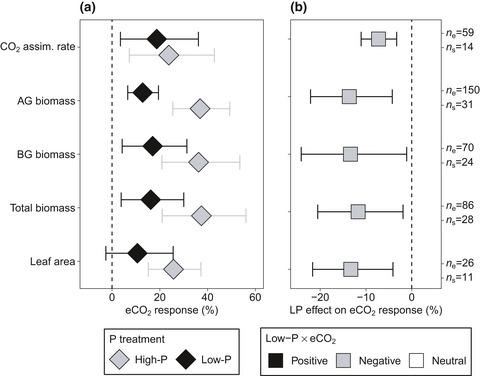当前位置:
X-MOL 学术
›
Glob. Change Biol.
›
论文详情
Our official English website, www.x-mol.net, welcomes your
feedback! (Note: you will need to create a separate account there.)
Low phosphorus supply constrains plant responses to elevated CO2 : A meta-analysis.
Global Change Biology ( IF 10.8 ) Pub Date : 2020-07-12 , DOI: 10.1111/gcb.15277 Mingkai Jiang 1 , Silvia Caldararu 2 , Haiyang Zhang 1 , Katrin Fleischer 3 , Kristine Y Crous 1 , Jinyan Yang 1 , Martin G De Kauwe 4 , David S Ellsworth 1 , Peter B Reich 1, 5 , David T Tissue 1 , Sönke Zaehle 2 , Belinda E Medlyn 1
Global Change Biology ( IF 10.8 ) Pub Date : 2020-07-12 , DOI: 10.1111/gcb.15277 Mingkai Jiang 1 , Silvia Caldararu 2 , Haiyang Zhang 1 , Katrin Fleischer 3 , Kristine Y Crous 1 , Jinyan Yang 1 , Martin G De Kauwe 4 , David S Ellsworth 1 , Peter B Reich 1, 5 , David T Tissue 1 , Sönke Zaehle 2 , Belinda E Medlyn 1
Affiliation

|
Phosphorus (P) is an essential macro‐nutrient required for plant metabolism and growth. Low P availability could potentially limit plant responses to elevated carbon dioxide (eCO2), but consensus has yet to be reached on the extent of this limitation. Here, based on data from experiments that manipulated both CO2 and P for young individuals of woody and non‐woody species, we present a meta‐analysis of P limitation impacts on plant growth, physiological, and morphological response to eCO2. We show that low P availability attenuated plant photosynthetic response to eCO2 by approximately one‐quarter, leading to a reduced, but still positive photosynthetic response to eCO2 compared to those under high P availability. Furthermore, low P limited plant aboveground, belowground, and total biomass responses to eCO2, by 14.7%, 14.3%, and 12.4%, respectively, equivalent to an approximate halving of the eCO2 responses observed under high P availability. In comparison, low P availability did not significantly alter the eCO2‐induced changes in plant tissue nutrient concentration, suggesting tissue nutrient flexibility is an important mechanism allowing biomass response to eCO2 under low P availability. Low P significantly reduced the eCO2‐induced increase in leaf area by 14.3%, mirroring the aboveground biomass response, but low P did not affect the eCO2‐induced increase in root length. Woody plants exhibited stronger attenuation effect of low P on aboveground biomass response to eCO2 than non‐woody plants, while plants with different mycorrhizal associations showed similar responses to low P and eCO2 interaction. This meta‐analysis highlights crucial data gaps in capturing plant responses to eCO2 and low P availability. Field‐based experiments with longer‐term exposure of both CO2 and P manipulations are critically needed to provide ecosystem‐scale understanding. Taken together, our results provide a quantitative baseline to constrain model‐based hypotheses of plant responses to eCO2 under P limitation, thereby improving projections of future global change impacts.
中文翻译:

低磷供应限制了植物对升高的二氧化碳的响应:一项荟萃分析。
磷(P)是植物新陈代谢和生长所必需的重要常量营养素。磷的低供应量可能会限制植物对升高的二氧化碳(eCO 2)的反应,但是对于这种限制的程度尚未达成共识。在此,基于对木本和非木本物种的年轻个体进行CO 2和P操纵的实验数据,我们对磷限制对植物生长,对eCO 2的生理和形态响应的影响进行了荟萃分析。我们表明,低磷可用性降低了植物对eCO 2的光合响应约四分之一,导致对eCO 2的光合响应降低,但仍为正与高磷可用性下的那些相比。此外,低磷限制了植物对地上,地下和总生物量对eCO 2的响应,分别降低了14.7%,14.3%和12.4%,相当于在高P利用率下观察到的eCO 2响应大约减半。相比之下,低磷有效性并没有显着改变eCO 2诱导的植物组织养分浓度的变化,这表明组织养分柔韧性是重要的机制,允许低磷有效性下生物量对eCO 2的响应。低磷显着降低了eCO 2诱导的叶面积增加14.3%,反映了地上生物量响应,但低P并没有影响eCO 2导致根长增加。木本植物比非木本植物对低磷对地上生物量对eCO 2的响应表现出更强的衰减作用,而具有不同菌根协会的植物对低P和eCO 2相互作用表现出相似的响应。这项荟萃分析突出显示了在捕获工厂对eCO 2和低磷可用性的响应方面的关键数据差距。为了提供对生态系统规模的了解,迫切需要对CO 2和P进行长期暴露的野外实验。两者合计,我们的结果提供了一个定量基线,以约束基于模型的植物对eCO 2响应的假设 在P限制下,从而改善了对未来全球变化影响的预测。
更新日期:2020-07-12
中文翻译:

低磷供应限制了植物对升高的二氧化碳的响应:一项荟萃分析。
磷(P)是植物新陈代谢和生长所必需的重要常量营养素。磷的低供应量可能会限制植物对升高的二氧化碳(eCO 2)的反应,但是对于这种限制的程度尚未达成共识。在此,基于对木本和非木本物种的年轻个体进行CO 2和P操纵的实验数据,我们对磷限制对植物生长,对eCO 2的生理和形态响应的影响进行了荟萃分析。我们表明,低磷可用性降低了植物对eCO 2的光合响应约四分之一,导致对eCO 2的光合响应降低,但仍为正与高磷可用性下的那些相比。此外,低磷限制了植物对地上,地下和总生物量对eCO 2的响应,分别降低了14.7%,14.3%和12.4%,相当于在高P利用率下观察到的eCO 2响应大约减半。相比之下,低磷有效性并没有显着改变eCO 2诱导的植物组织养分浓度的变化,这表明组织养分柔韧性是重要的机制,允许低磷有效性下生物量对eCO 2的响应。低磷显着降低了eCO 2诱导的叶面积增加14.3%,反映了地上生物量响应,但低P并没有影响eCO 2导致根长增加。木本植物比非木本植物对低磷对地上生物量对eCO 2的响应表现出更强的衰减作用,而具有不同菌根协会的植物对低P和eCO 2相互作用表现出相似的响应。这项荟萃分析突出显示了在捕获工厂对eCO 2和低磷可用性的响应方面的关键数据差距。为了提供对生态系统规模的了解,迫切需要对CO 2和P进行长期暴露的野外实验。两者合计,我们的结果提供了一个定量基线,以约束基于模型的植物对eCO 2响应的假设 在P限制下,从而改善了对未来全球变化影响的预测。











































 京公网安备 11010802027423号
京公网安备 11010802027423号